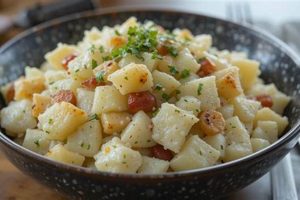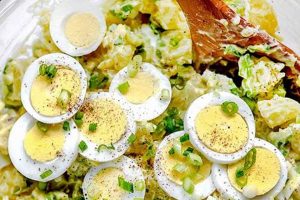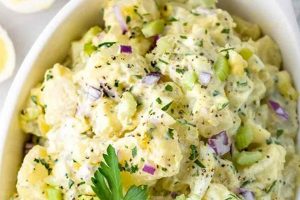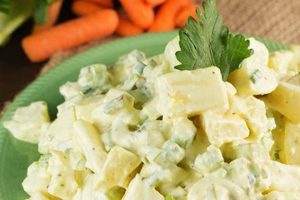A guide to preparing a specific dish, potato salad flavored with dill, typically involves a list of ingredients (potatoes, dill, other vegetables, seasonings, and a dressing) alongside step-by-step instructions for combining and preparing them. Variations exist, including the type of potato used, the addition of other ingredients like hard-boiled eggs or onions, and the choice of dressing, which might range from a simple vinaigrette to a mayonnaise-based one.
Documented culinary traditions demonstrate the longstanding popularity of potato salad in various cultures. Dill, with its bright, tangy flavor, offers a refreshing counterpoint to the richness of potatoes, making this particular variation a popular choice, especially during warmer months. This dish offers versatility, serving as a standalone side, a component of a larger meal, or an element within a buffet spread. The relative ease of preparation and adaptability to different tastes contribute to its enduring appeal.
The following sections will delve into specific ingredient selections, offer variations on the basic preparation method, and provide helpful tips for achieving optimal flavor and texture.
Tips for Dill Potato Salad
Optimizing ingredient selection and preparation techniques enhances the flavor and texture of dill potato salad. Attention to detail ensures a successful and enjoyable culinary experience.
Tip 1: Potato Selection: Waxy potatoes, such as red or new potatoes, hold their shape well after cooking and are preferable to starchy varieties. Avoid russet potatoes, which tend to become crumbly.
Tip 2: Cooking Method: Potatoes should be cooked until tender but not mushy. Overcooked potatoes will result in a less appealing texture. Steaming or boiling until just fork-tender is recommended.
Tip 3: Dill Incorporation: Fresh dill offers the most vibrant flavor. Incorporate both chopped fresh dill into the dressing and sprigs as a garnish for visual appeal and added aroma.
Tip 4: Dressing Enhancement: A balanced dressing is key. A combination of mayonnaise, vinegar (such as white wine or apple cider vinegar), and Dijon mustard creates a flavorful base. Adjusting the ratios allows customization to individual preferences.
Tip 5: Complementary Ingredients: Consider additions like chopped celery, red onion, or hard-boiled eggs for added flavor and textural contrast. These ingredients should be incorporated after the potatoes have cooled slightly to prevent overcooking.
Tip 6: Chilling Time: Allowing the potato salad to chill for at least an hour before serving allows the flavors to meld. This enhances the overall taste experience.
Tip 7: Seasoning Adjustment: Seasoning should be adjusted after chilling as flavors can dull during refrigeration. A final taste test allows for necessary adjustments to salt and pepper levels.
Following these guidelines will result in a dill potato salad with balanced flavors, appealing textures, and an attractive presentation.
By understanding these core principles, one can confidently create a dill potato salad tailored to individual preferences.
1. Ingredients
Ingredients form the foundation of any dish, and dill potato salad is no exception. The careful selection and balance of ingredients directly determine the final flavor profile, texture, and overall quality of the salad. Consider the interplay between potatoes, dill, and the dressing. Waxy potatoes, such as red bliss or fingerlings, hold their shape better than starchy varieties like russets, contributing to a desirable texture. Fresh dill provides a brighter, more pronounced flavor compared to dried dill, influencing the overall taste. The dressing, whether a simple vinaigrette or a richer mayonnaise-based option, further shapes the character of the salad. For example, a lemon-dill vinaigrette lends a tangy, refreshing quality, while a creamy dill dressing offers a more traditional, comforting flavor.
The quality of individual ingredients also plays a significant role. Fresh, high-quality potatoes result in a superior salad compared to older, less flavorful ones. Similarly, using fresh dill, when available, elevates the taste compared to dried dill. Consider other complementary ingredients like hard-boiled eggs, celery, or red onion. These additions introduce textural and flavor complexity. For instance, the crunch of celery provides contrast to the softness of the potatoes, while the sharpness of red onion balances the richness of the dressing. The judicious inclusion of such ingredients allows for customization and adds depth to the overall culinary experience.
Understanding the relationship between ingredients and the final product is crucial for creating a successful dill potato salad. It allows for informed choices regarding ingredient selection, proportions, and combinations, empowering one to craft a salad tailored to specific preferences. While a basic recipe provides a starting point, appreciating the impact of each ingredient enables adaptation and experimentation, leading to a more personalized and satisfying culinary outcome. This knowledge also allows for troubleshooting. If a salad is too bland, it might indicate a need for more acid or salt. If the texture is undesirable, it might suggest the wrong potato variety was used or that the potatoes were overcooked. By analyzing the interplay of ingredients, one can diagnose and rectify such issues, ensuring a consistently delicious and well-balanced dill potato salad.
2. Preparation
Preparation forms the crucial bridge between a list of ingredients and a realized dill potato salad. Methodical preparation ensures that individual components contribute harmoniously to the final product. This encompasses several key stages, each impacting the overall quality and enjoyment of the dish. Initial steps involve washing and preparing the potatoes. Whether diced, sliced, or left whole, uniformity in size ensures even cooking. Overcooked potatoes result in a mushy texture, while undercooked potatoes remain unpleasantly firm. Therefore, careful attention to cooking time and method, whether boiling or steaming, is essential. Cooling the potatoes adequately before adding the dressing prevents the dressing from breaking down and becoming oily. It also helps the potatoes absorb the flavors of the dressing more effectively.
The preparation of other ingredients also merits attention. Chopping fresh dill finely ensures even distribution of flavor throughout the salad. Hard-boiled eggs, if included, require precise timing to achieve the desired yolk consistency. Other additions, such as celery or red onion, benefit from consistent chopping to ensure a balanced texture and prevent overpowering any single element. The order of operations contributes significantly to a successful outcome. For example, combining the dressing ingredients separately allows for optimal emulsification before incorporating them with the potatoes and other components. Adding delicate ingredients like fresh dill toward the end prevents them from wilting or losing their vibrancy. Furthermore, attention to hygiene throughout the preparation process is paramount. Washing hands and using clean utensils minimizes the risk of contamination and ensures food safety.
A well-executed preparation stage translates directly to a superior dill potato salad. It ensures the desired texture, maximizes flavor development, and enhances the overall aesthetic appeal of the dish. Conversely, neglecting proper preparation techniques can lead to a less satisfying result, impacting both taste and presentation. Ultimately, meticulous preparation elevates the dish beyond a simple combination of ingredients, transforming it into a cohesive and enjoyable culinary experience. This careful approach distinguishes a truly exceptional dill potato salad from a mediocre one.
3. Dill Integration
Dill integration is crucial for a successful dill potato salad, impacting the final flavor profile significantly. The method and timing of dill incorporation influence the herb’s prominence and overall balance within the dish.
- Fresh Dill Incorporation
Fresh dill offers the most vibrant flavor and aroma. Chopping it finely before adding it to the salad ensures even distribution and prevents large, overpowering sprigs. Incorporating fresh dill towards the end of the preparation process, after the potatoes have cooled, preserves its delicate flavor and prevents wilting. This method maximizes the fresh, herbaceous notes of the dill.
- Dried Dill Incorporation
Dried dill provides a more subtle, earthy flavor compared to fresh dill. It requires rehydration before use to maximize its impact. This can be achieved by soaking the dried dill in warm water or incorporating it directly into the dressing, allowing it to absorb moisture and release its flavor compounds. Due to its concentrated nature, dried dill should be used sparingly to avoid overpowering the other flavors in the salad.
- Dill in Dressing vs. Dill in Salad
Dill can be incorporated directly into the salad or infused into the dressing. Adding dill to the dressing allows its flavor to permeate the other ingredients more thoroughly. Conversely, adding it directly to the salad provides bursts of intense dill flavor in each bite. Combining both methods offers a balanced approach, layering the dill flavor throughout the dish while retaining pockets of fresh dill prominence.
- Dill Flavor Pairing
Dill complements other ingredients commonly found in potato salad, such as lemon, vinegar, and mustard. Consider these flavor pairings when determining the overall flavor profile of the salad. For instance, a lemon-dill vinaigrette enhances the brightness of fresh dill, while a creamy dill dressing, incorporating mayonnaise and sour cream, provides a richer, more traditional flavor experience. Understanding these flavor dynamics allows for a more nuanced approach to dill integration, creating a balanced and harmonious final product.
Successful dill integration elevates the dill potato salad from a simple side dish to a flavorful and aromatic culinary experience. The method of incorporation directly influences the final taste and overall enjoyment of the salad. Whether using fresh or dried dill, incorporating it into the dressing or the salad itself, understanding these nuances allows for customization and optimization of the dill’s flavor profile, ensuring a well-balanced and satisfying result.
4. Dressing Choice
Dressing choice significantly influences the overall flavor profile and character of a dill potato salad. The dressing acts as a unifying element, binding the ingredients together and imparting a distinct taste that complements the potatoes and dill. Selecting the appropriate dressing requires consideration of the desired balance between creaminess, tanginess, and herbaceousness.
- Classic Mayonnaise-Based Dressing
This traditional approach utilizes mayonnaise as the foundation, providing a rich, creamy texture and a slightly tangy flavor. Additions such as mustard, vinegar, and seasonings further enhance the complexity. This style offers a familiar comfort and complements the earthiness of the potatoes and the brightness of the dill. Variations include incorporating sour cream or yogurt for a lighter texture or adding a touch of sweetness with honey or maple syrup.
- Vinaigrette-Based Dressing
A vinaigrette offers a lighter, brighter alternative to mayonnaise-based dressings. Typically composed of oil, vinegar, and seasonings, vinaigrettes provide a refreshing tang and allow the flavors of the potatoes and dill to shine through. Lemon juice or apple cider vinegar are popular choices, complementing the herbaceous notes of the dill. Variations include incorporating Dijon mustard for a creamy texture or adding herbs like chives or parsley for additional complexity.
- Dairy-Based Dressing
Dressings incorporating sour cream, buttermilk, or yogurt provide a creamy texture while offering a tangier profile than mayonnaise-based dressings. These options provide a lighter alternative, balancing the richness of the potatoes. Dill integrates seamlessly into dairy-based dressings, its herbaceous notes complementing the tangy base. Variations include adding fresh herbs, spices, or a touch of horseradish for added depth of flavor.
- Vegan Dressing Options
Vegan alternatives to traditional dressings utilize plant-based ingredients to achieve similar flavor profiles and textures. Vegan mayonnaise, cashew cream, or avocado can serve as the base for creamy dressings. Vinaigrettes using olive oil, lemon juice, and herbs provide a light and refreshing option. Nutritional yeast can add a cheesy flavor, while tahini provides a nutty richness. These options cater to dietary restrictions while maintaining the flavor integrity of the dill potato salad.
The chosen dressing profoundly impacts the overall sensory experience of the dill potato salad. A careful consideration of the different dressing styles and their flavor profiles ensures a harmonious balance of ingredients, resulting in a dish that is both flavorful and satisfying. Whether opting for the classic richness of a mayonnaise-based dressing, the refreshing tang of a vinaigrette, the lighter creaminess of a dairy-based option, or the inclusivity of a vegan alternative, the dressing choice ultimately defines the character of the dill potato salad.
5. Potato Type
Potato variety significantly influences the texture and overall success of dill potato salad. Different potato types possess varying starch content and moisture levels, impacting their behavior during cooking and their ultimate texture within the salad. Selecting the appropriate potato is crucial for achieving the desired outcome. Waxy potatoes, such as red bliss, fingerling, or new potatoes, are ideal for potato salad. Their lower starch content allows them to hold their shape after boiling, preventing a mushy or crumbly texture. They maintain a firm bite, contributing to a pleasant textural experience. Conversely, starchy potatoes like russets, while excellent for baking or mashing, are less suitable for potato salad. Their high starch content causes them to break down during cooking, resulting in a softer, less defined texture that does not hold up well in a salad. For example, using russet potatoes in a dill potato salad might result in a disintegrated, unappetizing mixture, whereas waxy potatoes retain their individual shape and create a more visually appealing and texturally pleasing salad.
Beyond texture, potato type subtly influences the flavor profile of the salad. Waxy potatoes offer a slightly sweet, earthy flavor that complements the brightness of the dill. Starchy potatoes, while also possessing a natural sweetness, can sometimes impart a slightly floury taste that might clash with the delicate dill flavor. Therefore, choosing a waxy potato not only ensures a desirable texture but also enhances the overall flavor balance of the salad. Furthermore, the choice of potato affects the absorption of the dressing. Waxy potatoes, with their denser structure, absorb the dressing more evenly, ensuring that each bite is flavorful and well-coated. Starchy potatoes, on the other hand, tend to absorb the dressing unevenly, potentially leading to pockets of excessive dressing or dry, unflavored areas within the salad.
Understanding the relationship between potato type and the final characteristics of dill potato salad is essential for creating a successful dish. Selecting the appropriate potato ensures a pleasant texture, enhances flavor balance, and promotes even dressing absorption. This knowledge empowers informed choices, allowing for a more predictable and satisfying culinary outcome. Ignoring the significance of potato type can lead to textural disappointments and compromise the overall enjoyment of the dish. Selecting waxy potatoes, therefore, represents a key factor in achieving a dill potato salad with optimal texture and flavor.
6. Serving Suggestions
Serving suggestions provide crucial context for a dill potato salad recipe, elevating it from a mere set of instructions to a complete culinary experience. These suggestions offer insight into how the salad functions within a larger meal, enhancing its versatility and appeal. They demonstrate the dish’s adaptability, transforming it from a standalone side to a component of a more complex culinary narrative. For instance, recommending the dill potato salad as an accompaniment to grilled fish highlights its refreshing qualities, counterbalancing the richness of the fish. Suggesting it as part of a picnic basket emphasizes its portability and suitability for casual dining. Pairing it with a hearty sandwich underscores its role as a refreshing counterpoint to a heavier main course.
Effective serving suggestions consider the flavor profile of the dill potato salad. A salad with a tangy lemon-dill vinaigrette might be suggested alongside roasted chicken or vegetables, complementing their savory flavors. A creamier, mayonnaise-based dill potato salad might be paired with grilled meats or barbecued fare, offering a cooling contrast to the smoky flavors. These pairings demonstrate an understanding of flavor dynamics and provide practical guidance for incorporating the salad into a balanced meal. Further, serving suggestions can address variations in the recipe itself. A dill potato salad with hard-boiled eggs might be positioned as a more substantial side dish, suitable for a lighter lunch. A simpler version, focusing solely on potatoes and dill, might be recommended as a component of a larger buffet spread. These considerations allow for a tailored approach to serving suggestions, reflecting the specific characteristics of the prepared salad.
Ultimately, insightful serving suggestions enhance the value of a dill potato salad recipe. They provide practical applications, demonstrate the dish’s versatility, and contribute to a more satisfying culinary experience. By considering the flavor profile, context, and potential variations, serving suggestions transform a simple recipe into a source of culinary inspiration and guidance. They bridge the gap between preparation and consumption, ensuring that the dill potato salad reaches its full potential as a flavorful and enjoyable dish.
Frequently Asked Questions
This section addresses common inquiries regarding dill potato salad preparation, offering clarity and guidance for optimal results.
Question 1: What type of potato is best suited for dill potato salad?
Waxy potatoes, such as red bliss, fingerling, or new potatoes, are recommended. Their lower starch content helps them maintain their shape after cooking, preventing a mushy texture.
Question 2: Can dried dill be substituted for fresh dill?
While fresh dill offers superior flavor, dried dill can be substituted if necessary. Rehydrate dried dill in warm water before use or incorporate it directly into the dressing to maximize its flavor contribution. Use dried dill sparingly due to its concentrated nature.
Question 3: How long should potato salad be chilled before serving?
Chilling for at least one hour allows the flavors to meld and enhances the overall taste. Longer chilling times, up to 24 hours, are acceptable, but ensure proper refrigeration to maintain food safety.
Question 4: What can be added to dill potato salad for additional flavor?
Common additions include chopped celery, red onion, hard-boiled eggs, and crumbled bacon. These ingredients provide textural and flavor complexity, complementing the potatoes and dill. Other options include capers, pickles, or chopped fresh chives.
Question 5: How can one prevent potato salad from becoming watery?
Ensure the potatoes are cooked until tender but not overcooked. Drain them thoroughly and allow them to cool completely before adding the dressing. Avoid overdressing the salad, as excess dressing can contribute to a watery consistency.
Question 6: How long can dill potato salad be stored?
Properly stored in an airtight container in the refrigerator, dill potato salad can last for three to five days. Monitor for any signs of spoilage, such as off-odors or discoloration, before consuming.
Understanding these key aspects of dill potato salad preparation ensures a successful and enjoyable culinary outcome. Addressing these common questions provides a foundation for creating a flavorful and well-balanced dish.
The following section provides a complete recipe for dill potato salad, incorporating the principles and tips discussed throughout this article.
Recipe for Dill Potato Salad
Exploration of the elements contributing to a successful dill potato salad reveals the importance of ingredient selection, preparation techniques, and flavor pairings. Waxy potatoes maintain desirable texture, while fresh dill provides optimal flavor. Dressing choice significantly influences the overall character of the dish, ranging from creamy mayonnaise-based options to lighter vinaigrettes. Careful consideration of these factors ensures a harmonious balance of textures and tastes.
Culinary traditions evolve through experimentation and adaptation. This examination of dill potato salad provides a foundation for both classic preparations and innovative variations. Application of these principles allows for personalized interpretations, ensuring a consistently satisfying and enjoyable culinary experience.






